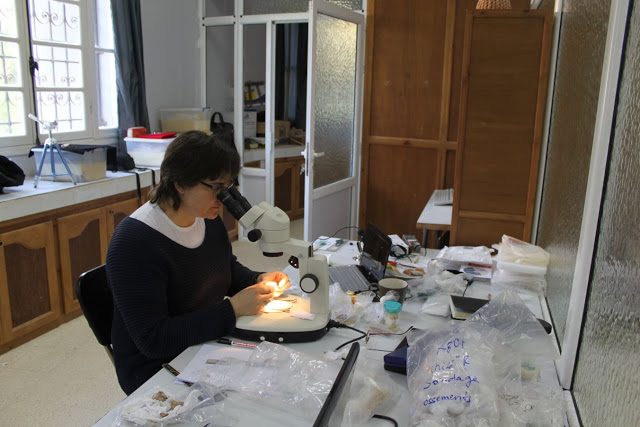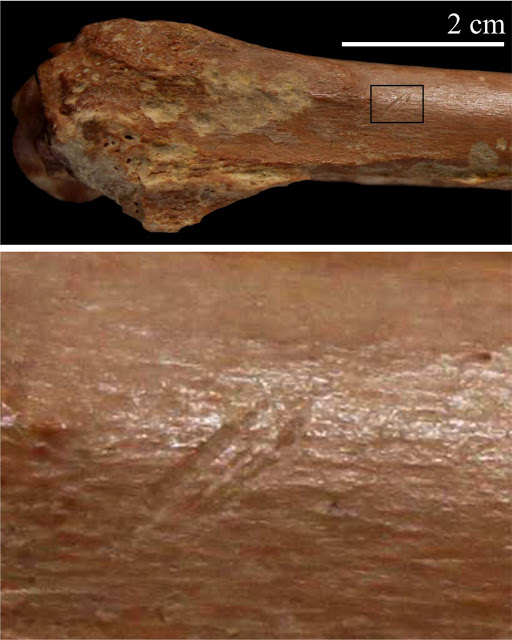03/12/2018
1.9 million and 2.4 million-year-old artefacts and stone tool cutmarked bones from Ain Boucherit, Algeria
Until recently, most paleoanthropologists believed that early hominins dispersed into Northern Africa much later. The journal Science publish an article about this question and one of the authors is an IPHES-URV researcher, Isabel Cáceres, the taphonomist of the project

Until recently, most paleoanthropologists believed that early hominins dispersed into Northern Africa much later. The journal Science publish an article about this question and one of the authors is an IPHES-URV researcher, Isabel Cáceres, the taphonomist of the project
Until this publication, the earliest archaeological evidence for the Oldowan and associated fossil bones with evidence of butchery is known from the 2.6 million-year deposits at Gona (Ethiopia). Until recently, most paleoanthropologists believed that early hominins dispersed into Northern Africa much later. Continued research at Ain Hanech (Sétif, Algeria) over the past two decades has expanded the geographic range of early hominin settlement in North Africa, also pushing back the evidence for ancestral hominin fashioning of stone tools and carnivore to 2.4 million years ago (Ma). During the previous decade, we have documented stone artefacts and stone tool cutmarked bones at Ain Hanech dated to circa 1.8 Ma, proving the potential of this area for yielding even much older archaeological materials.
Scientists from CENIEH (Spain), CNRPAH (Algeria), IPHES and URV (Spain), CSIC/MNCN (Spain), Griffith University (Australia), University of Sétif 2 and University of Algiers 2 (Algeria), and IPH-MNHN (France) conducting field excavations at the older nearby Ain Boucherit have discovered the oldest artefacts and stone tool cutmarked bones currently known in North Africa. The stone tools and associated fossil bones were excavated from two distinct archaeological levels at Ain Boucherit: The lower level (AB-Lw) and upper level (AB-Up) situated in a sedimentary outcrop exposed by a deep ravine. The archaeological materials were excavated at two levels within the Ain Hanech geological formation and are estimated to ~2.4 Ma and to ~1.9 (Ma), respectively.
The Ain Boucherit stone tools were made of locally available limestone and flint and include chopping tools, subspheroids, and sharp-edged cutting tools used for processing animal carcasses. The hominins collected the rocks used for making the stone tools from nearby ancient stream beds. The artefacts are typical of the Oldowan stone technology known from 2.6-1.9 million-year-old sites in East Africa, although those from Ain Boucherit show subtle variations.

Dr. M. Sahnouni, the lead author and director of the Ain Hanech project, said: “the Ain Boucherit archaeology, which is technologically similar to the Gona Oldowan, shows that our ancestors ventured into all corners of Africa, not just East Africa. The evidence from Algeria has changed earlier view regarding East Africa being the cradle of humankind. Actually, the entire Africa was the cradle of humankind”.
The fossilized bones associated with the archaeological materials include a variety of savanna type animals such as mastodons, elephants, horses, rhinos, hippos, wild antelopes, pigs, hyenas, crocodiles, etc. Currently such animals occupy a relatively open savanna type habitats with permanent body of water nearby. The fossilized bones preserving stone tool cutmarks are primarily composed of small and medium-sized bovids and equids, which are anatomically represented by upper and lower limbs, followed by cranial and axial elements.
The evidence from Ain Boucherit unambiguously shows that ancestral hominins exploited meat and marrow from all animal size categories and skeletal parts involving skinning, evisceration, and deflesh activities. Dr. Isabel Caceres, the project taphonomist, commented that: “the effective use of knife-like cutting stone tools at Ain Boucherit suggests that our ancestors were not mere scavengers. Not clear at this time whether or not they hunted, but the evidence clearly showed that they were successfully competing with carnivores for meat and enjoyed first access to animal carcasses”.
It can be argued that North Africa and the Sahara are a repository of troves of fossil and archaeological materials, but the inhospitable nature of this vast area has hindered systematic and intensive investigations. Despite its considerable geographical distance from East Africa, the evidence from Ain Boucherit clearly argues for rapid expansion of stone tool manufacture from East Africa or for possible multiple origin scenario of stone tool manufacture in both East and North Africa. Based on the potential of Ain Boucherit and the adjacent sedimentary basins, it can be suggested that hominin fossils and Oldowan artifacts as old as those documented in East Africa could be discovered in North Africa.
